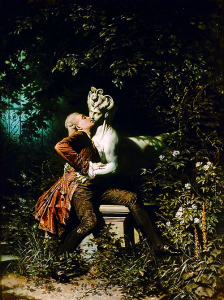Inspiration from Heinrich Heine’s “Book of Songs”
“The Enchantress (The Sphinx and The Poet)” is a mesmerizing painting by Heinrich Lossow, inspired by the “Book of Songs” written by the renowned German poet Heinrich Heine. The artwork depicts a young poet being drawn into a kiss by a sphinx, while simultaneously being wounded by her sharp paws.
Lossow’s Artistic Interpretation and Romanticism
Lossow masterfully avoids an overtly violent portrayal of the embrace and instead infuses the scene with a sweet sense of romanticism. He achieves this by dressing the young poet in Rococo garb, which was one of his signature styles. Lossow’s mastery of the Rococo style is evident throughout his body of work, as he often employed this approach in his paintings.
A Young Artist’s Creation
Lossow painted “The Enchantress” when he was just 28 years old, showcasing his immense talent and skill at a young age. In the painting, the young poet succumbs to the erotic allure of a granite garden sphinx, as they become entwined in a passionate embrace.
The Mastery of Light and Shadow
One of the most striking features of “The Enchantress” is Lossow’s exceptional use of light and shadow. He bathes the entire scene in soft moonlight, creating an ethereal atmosphere with pale whites and blues. The shadows cast by the leaves on the sphinx further enhance the overall visual impact of the painting.
Garden or Cemetery? A Mysterious Setting
The abundant vegetation and the moonlit gate in the background evoke an air of mystery, as it becomes unclear whether the scene takes place in a garden or a cemetery. This ambiguous setting adds another layer of intrigue to the painting, inviting viewers to ponder the deeper meaning behind the enchanting scene.
The Embrace: A Unique Role Reversal
Arguably the most captivating aspect of “The Enchantress” is the role reversal in the embrace between the male and female figures. Instead of the male figure embracing the female sphinx, it is the sphinx who tenderly yet dangerously embraces the young poet. This unexpected twist challenges traditional gender roles and adds depth to the story being told through Lossow’s masterful brushstrokes.
Symbolism and Themes in “The Enchantress”
The painting “The Enchantress (The Sphinx and The Poet)” is rich in symbolism, conveying a variety of themes such as love, danger, and mystery. The sphinx’s embrace of the young poet represents both the allure and the peril of passionate love. This duality is emphasized by the delicate balance between the tender kiss and the potentially harmful grip of the sphinx’s paws.
The Sphinx: A Mythical Creature of Enigma
The choice of the sphinx as the central figure adds a layer of enigma and allure to the painting. Known for their riddles and mysterious nature in mythology, sphinxes often symbolize the inscrutable aspects of life, knowledge, and power. The female sphinx’s seductive allure represents the captivating yet enigmatic nature of romantic love and the inherent risks that come with it.
Rococo Style: A Reflection of the Time
Lossow’s use of the Rococo style in “The Enchantress” is a testament to his ability to capture the essence of an era. Rococo, an 18th-century artistic movement characterized by ornate details, pastel colors, and elegant, curving forms, serves as the perfect backdrop for the story of a passionate encounter between a poet and a mythical creature. The choice of this style also reflects Lossow’s affinity for the period and his skill in incorporating its elements into his work.
The Enchantress: A Lasting Impact
Heinrich Lossow’s “The Enchantress (The Sphinx and The Poet)” is a visually stunning and thought-provoking work of art that continues to captivate audiences with its skillful use of light, shadow, and symbolism. The painting serves as a timeless reminder of the complexities of love, the allure of mystery, and the power of art to evoke emotion and inspire contemplation.
